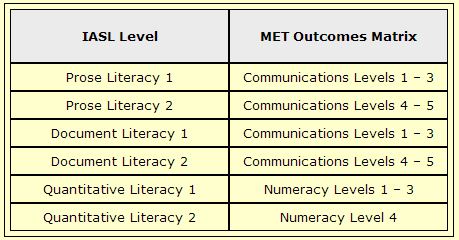HRSDC’s Essential Skills Research Project team defined the five ES complexity levels by basing them on the 500-point scale used in the International Adult Literacy Survey (IALS). For example, ES Level 1 refers to tasks rated 0—225 on the IALS continuum, or those that indicate very basic literacy skills. At the high end of the ES scale, Level 5 compares to IALS 376-500, or tasks that require significantly more time and prior knowledge to interpret dense and complex texts and make high-level inferences, and where the consequences of making mistakes are greater.
Literacy practitioners might consider generally referring to occupational profiles where tasks fall under ES Levels 1 and 2, as tasks higher up the continuum may pose too great a challenge for beginning learners.
The Ontario Literacy Coalition commented in their 2005 response to the Association of Colleges of Applied Arts and Technology’s (ACAAT)) Pathways to Prosperity consultations that LBS levels 1 through 3 “roughly correspond” to IALS level 1. Again, there is yet to be a validated articulation, but the OLC’s reference provides a good working guide. Therefore, it may be safe to say that LBS level 1 through 3 learners are likely capable of completing tasks rated level 1 on the ES complexity scale, since the ES and IALS scales are comparable.
The following table was borrowed from the Ministry of Education and Training’s – Learning Outcomes Matrix – 1998:

For each ES profile, job-related tasks have been identified through interviews with actual workers in that occupation, and examples are provided to show the range of complexity of required tasks. Many of the tasks have also been rated according to whether they are typical and/or most complex.
A typical task:
- Required by virtually all workers in the identified occupation
- Occurs frequently within the occupation
Most complex tasks:
- Identified by some or all workers as being the most difficult of the required on-the-job duties
- May also be identified as typical
Task ratings are influenced by:
- Actual difficulty of the task
- Frequency in which the task is performed
- Familiarity with the task
- The degree of the individual’s responsibility
- The consequences of error
- A task may be rated as both typical and most complex
It should be noted that with reference to most complex tasks, the ratings are often presented as a range, as the complexity of required tasks vary within most occupational groups. For example, if the rating is 2 to 4, it means that all of the jobs within the occupational group involve complexity level 2 tasks, and that some of the jobs include complexity level 4 tasks.
This is useful information for adult learners who are interested in a particular occupational group that includes some tasks beyond their identified level of proficiency. If the learner is able to perform most of the tasks required, those tasks rated as being most complex could be added to the learner’s training plan as targets for further skill development.
The Initial and Ongoing Assessment module on Literacy Basics (www.nald.ca/literacybasics/initial/lbs/01.htm) includes an excellent description of LBS levels that may be helpful when trying to determine the relationship between LBS and ES levels.
Questions and Activities for Reflection
- What indicators have you relied on to measure student progress?
- How have you determined what tasks are appropriate to use with learners in your agency?
- Did you know that Essential Skills levels of complexity accommodate using the same documents with varied level learners? Consider the ways you might work with an income tax form so that both lower and higher level learners are equally challenged. How will ES definitions, levels of complexity, and task examples help you create appropriate learning activities?
Pages: 1 2




